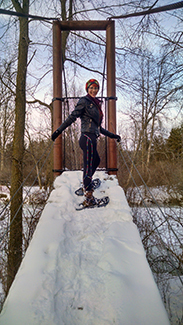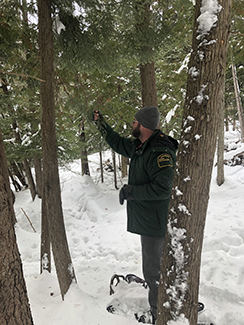Letting you in on a snowshoe secret
By RACHEL COALE
Michigan Department of Natural Resources

Snowshoeing feels like a secret.
In the quiet winter forest, I rarely encounter other hikers. Watching my breath hang in the frigid air with a thumping heartbeat and sting of snowflakes on my cheeks is a refreshingly vital experience in a season where it’s all too easy to burrow into a pile of blankets and watch Netflix.
Some people love to whiz down ski hills at top speed – and that’s a great winter activity – but the muffled, rhythmic “crunch – crunch – crunch” of snowshoes on a trail is a different kind of experience. It allows for reflection and observation in a way that most other winter activities don’t.
If you haven’t experienced the peaceful quietude of Michigan’s winter forests, I invite you to put a foot forward on the trail and enjoy the snowy outdoors. Pack some cocoa.
Getting started
“Getting started snowshoeing is easy,” says REI Co-op’s intro-to-snowshoeing webpage. “If you can walk, you can snowshoe.”
The activity is physically low-impact and doesn’t require many special techniques. But don’t be fooled that it will be too easy; the exercise can get you huffing and puffing like on a treadmill, but with far more interesting scenery.
It’s also low-cost. You don’t need a lift ticket or club membership to go snowshoeing, or even a trail. Michigan’s 4 million acres of state forest are open to the public for free year-round, so all that’s needed are a few pieces of gear.
The Muskegon Winter Sports Complex in Muskegon State Park offers snowshoe rentals for those who want to try it out before investing in their own pair, and the facility also offers adaptive ski and skate equipment for wheelchair users. For those who are ready to purchase their own, snowshoe kits (these often come with a carry bag and poles) range from $40 to $120 depending on size and materials.
|

Whether you choose newer-style, metal-frame snowshoes or the classic wood-frame variety, in the case of snowshoes – size matters. Smaller snowshoes with less “flotation” are best for wet, compact snow, while hikes in powder snow require larger snowshoes. Other features to consider are the type of bindings (these attach your boots to the snowshoes), heel lifts (they can help on hill climbs) and crampons – spiky cleats that that provide traction and stability.
In addition to the snowshoes themselves, many winter hikers use hiking poles or ski poles for added balance and to test for hazards (like logs, deep holes or thin ice) that can hide beneath fresh snow.
A few essentials to bring on a winter day hike in the forest include:
- Snowshoes and warm, waterproof boots.
- Clothing in layers: a wicking base layer, warm middle layer and outer shell.
- A water bottle or hydration bladder and a snack.
- A map of the route you wish to take.
- A change of clothing in case you get wet.
A recommended piece of equipment that may be surprising is a pair of sunglasses. Although they seem more suited to a summer hiking kit, they can be helpful on bright days when sunlight reflecting off glittering snow can be blinding.
|

With snowshoes, you can follow an established path or break a new trail but avoid snowshoeing on groomed cross-country ski tracks. Skiers do have the right-of-way on shared trail systems (it’s easier for a snowshoer to step off the trail than it is for a skier to go off-track).
Before heading into the woods, always leave a hike plan with someone you trust and a copy under your car seat.
For play – and work too
Snowshoeing is a great weekend recreational activity, but if you’re a forester, it’s part of the job. Michigan Department of Natural Resources foresters use snowshoes to trek through deep snow to evaluate timber and check trees for pests and diseases.
“It’s a great way to get out and enjoy some fresh air and natural light during the long winter months,” said Upper Peninsula forest health specialist Simeon Wright. “Up here, we have to really embrace winter.”
Over the course of the 2018-19 season, forest health teams working to prevent a tiny, invasive insect called the hemlock woolly adelgid from killing trees covered thousands of acres of west Michigan terrain in their hiking boots and snowshoes.
Their efforts and treatments have paid off, with no new infested areas found during last season’s monitoring surveys.
Find your forest adventure
Michigan’s state forests – primarily located “knuckles north” on Michigan’s Lower Peninsula mitten and across portions of the Upper Peninsula – offer many opportunities for beautiful snowshoe hikes. In the Pigeon River Country State Forest, in the northern Lower Peninsula, lucky snowshoers might spot a wild elk.
|

Visitors to the Sand Lakes Quiet Area near Traverse City will experience a peaceful hike in a totally nonmotorized forest, and those hiking in the Lake Superior forest near Newberry will emerge from the woods at the Crisp Point Lighthouse, which sits on a rocky beach known for prime agate hunting.
Find your next forest hike on the DNR's interactive map at Michigan.gov/StateForests.
For a fun group experience, many state parks offer guided, lantern-lit or moonlight snowshoe hikes – a perfect way to spend a winter evening with friends and family.
Visit the DNR snowshoeing page for hike dates. Some state parks and other locations also host snowshoe-building weekend workshops where participants build their own pair of traditional wooden snowshoes, spend a rustic night around the campfire and enjoy a guided hike.
From the secret adventure of winter snowshoeing to fall leaf peeping hikes, Michigan’s state forests offer year-round scenic beauty and opportunities for adventure – no matter the weather.
|
Check out previous Showcasing the DNR stories in our archive at Michigan.gov/DNRStories. To subscribe to upcoming Showcasing articles, sign up for free email delivery at Michigan.gov/DNR.
/Note to editors: Contact: John Pepin, Showcasing the DNR series editor, 906-226-1352. Accompanying photos and a text-only version of this story are available below for download. Caption information follows. Credit Michigan Department of Natural Resources, unless otherwise noted.
Text-only version of this story.
Check: A Michigan Department of Natural Resources forester using snowshoes to help conduct a forest health check for signs of the hemlock woolly adelgid.
Coale: Author of this story, Rachel Coale, enjoying a snowshoe outing.
Gear: A park visitor using snowshoes and trekking poles at P.J. Hoffmaster State Park, which is situated in portions of Muskegon and Ottawa counties.
Hike: Park visitors enjoy a lantern-lit hike at Island Lake Recreation Area in Livingston County.
Snowshoe: A snowshoe-making workshop is shown from Ludington State Park in Mason County.
Tracks: Snowshoe tracks in the snow on a beautiful sunny afternoon are shown.
Trail: A lantern lit along a snowshoe trail at Island Lake Recreation Area in Livingston County.
Waterloo-1 and Waterloo-2: A lantern-lit trail awaits visitors at Waterloo Recreation Area in portions of Jackson and Washtenaw counties./
|